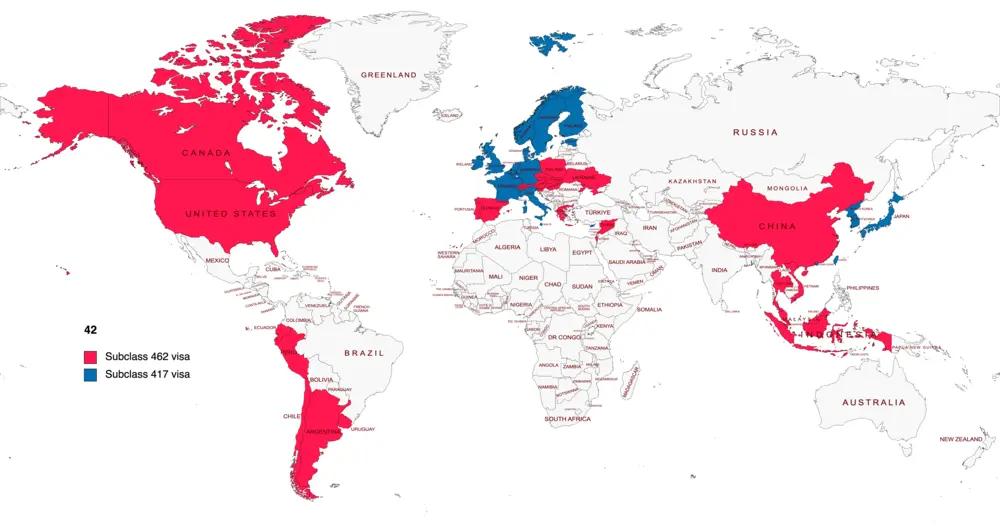If you’re starting to plan a working holiday to Australia then you are bound to have seen two visa subclasses pop up. They are the 417 visa and the 462 visa.
But what are these visas, and which one do you need to get for your Australian working holiday?
Well, before we get into the differences between a subclass 417 and 462 visa, it’s important to know that the country you hold a valid passport for will determine which visa subclass you need. The cost and duration of your working holiday to Australia are the same regardless which visa you get.
Read on to learn more.
What is the difference between a 417 visa and a 462 visa?
The Australian Government has developed two visa subclasses for the working holiday visa scheme: Subclass 417 and Subclass 462.
There are several differences between these two visa types which we will go through in more detail in this guide.
The most significant difference is the counties which are eligible to apply for each visa subclass.
Your passport country will determine your subclass visa
If you are from Belgium, Canada, Cyprus, Denmark, Estonia, Finland, France, Germany, Hong Kong, Republic of Ireland, Italy, Japan, Republic of Korea, Malta, Netherlands, Norway, Sweden, Taiwan, or the United Kingdom, then you can only apply for a subclass 417 visa.
If you are from Argentina, Austria, Chile, China, People’s Republic of, Czech Republic, Hungary, Indonesia, Israel, Luxembourg, Malaysia, Peru, Poland, Portugal, San Marino, Singapore, Slovak Republic, Slovenia, Spain, Thailand, Turkey, USA, Uruguay or Vietnam, then subclass 462 is your only option.

The age limit also varies between subclasses.
If you are eligible for an Australian working visa on subclass 417, then the age limit is 18 to 35 years – but that will depend on which country your passport is held in.
Only residents of Canada, France and the Republic of Ireland and be up to 35 years of age. If you are from any other country, then you must be aged 18 to 30 (inclusive).
On the 462 visa, every country has an age limit of 18 to 30 years.
Education requirements
Unlike the subclass 417 working holiday visa, applicants for the subclass 462 visa are required to have certain educational qualifications as set by the Immigration Department.
Visa 462 requires proof of proficiency in the English language
Subclass 462 visas require you to prove that you have adequate proficiency in the English language (with the exception of American citizens).
Subclass 417 working holiday visas do not require this.
You need to provide a letter of support on a subclass 462 visa
If you’re applying to go to Australia to work and travel on the visa subclass 462 you are required to provide a letter of support from your government of origin.
With a subclass 417 visa, you don’t need to provide a letter of support with visa your application.
The specified work is different between 417 and 462 visas
If you wish to apply for a second or third working holiday in Australia, you must have completed three months of specified work in approved industries and areas.
The type of work are different between a 417 visa and a 462 visa.
What does a subclass 417 visa and 462 visa cost?
There is no difference in price between a 417 and 462 visa.
The cost is $495 AUD for both.
Length of stay in Australia
Initially, you can obtain either type of visa for 12 months, but you can also apply for a second and third working holiday visa if you continue to meet the requirements.
Are there other criteria for an Australian working holiday visa?
As you can see by this detailed comparison between visa 417 and visa 462 for an Australian working holiday visa, the subclass 462 requires much more documentation than subclass 417.
There are standard criteria that you must meet regardless of which subclass you are applying for.
To be eligible for a working holiday visa to Australia you must:
- Be aged 18 to 35 years old (or 18 to 30 years for a 462 visa)
- Hold a valid passport from an eligible country
- Not previously been granted a 417 visa or 462 visa
- Not bring any dependent children with you
- Have sufficient funds available to cover living expenses while in Australia
- Have enough money to return home at the end of your working holiday visa
- Never had an Australian visa cancelled or an Australian visa application refused
- Accept the Australian Values Statement
- Meet the character requirements
- Meet minimum health standards (depending on your country of citizenship)
- Pay/arrange to pay any debts to the Australian Government
Hopefully this guide has helped clear up the differences between these two Australian visa types and now you are ready to apply on the official Australian Government website.

If you are still confused or unsure exactly how to move to Australia and secure a job, then we highly recommend that you check out Global Work and Travel.
They are the experts in working holiday visas and have helped thousands of people get their Australian working visas.
Not only that, but they offer you a guaranteed job interview before arrival, a dedicated trip coordinator, working holiday visa guidance a personal travel concierge plus much more!






